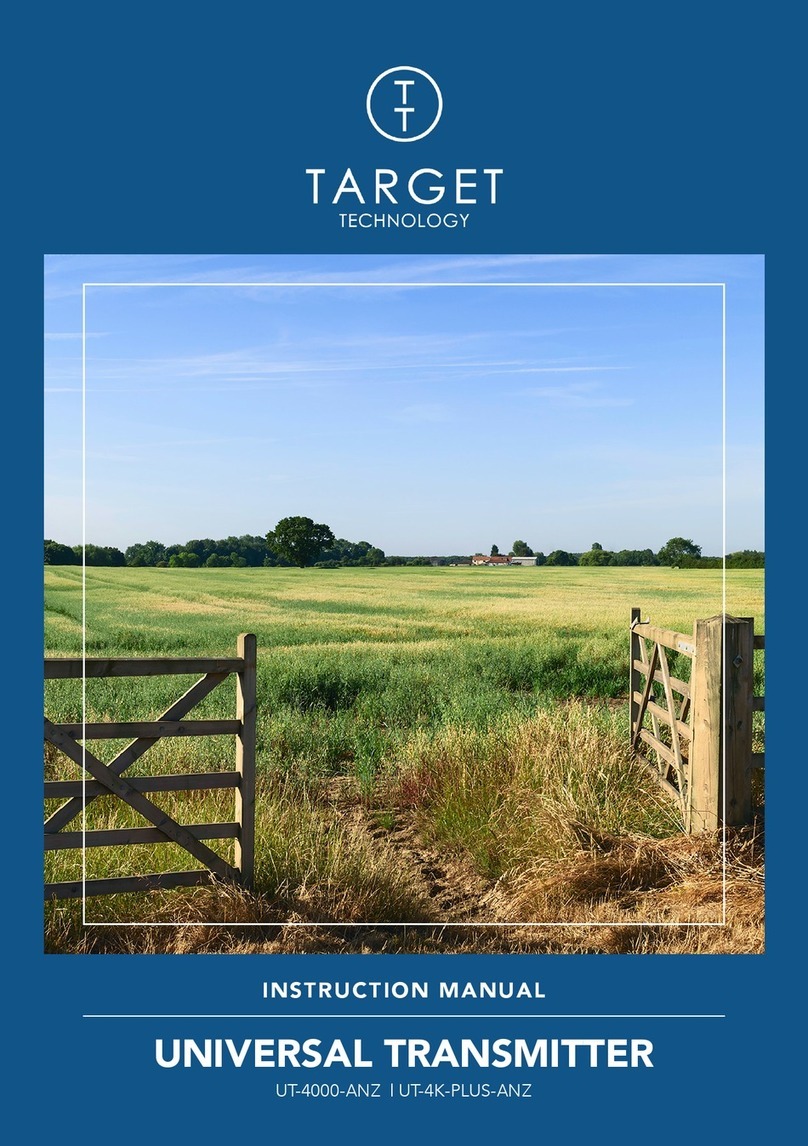
INSTALLING THE BATTERIES
1. Open the transmitter box lid.
2. Install four CR123A batteries (included). Make sure that the + and – symbols on the batteries match the symbols in
the compartment.
3. Close the transmitter box lid.
LOW BATTERY ALERT: If you hear a second alert 30 seconds after the first alert, and nothing has activated the
transmitter again, the batteries in the transmitter box are low and should be replaced.
POSITIONING YOUR TRANSMITTER
1. Lay the probe parallel to the driveway, then have a car drive by to
test its position. You should hear an alert through your receiver.
Note: The probe detects vehicles up to about 3m away.
2. Bury the probe and its wire:
• If your driveway is one-car wide, bury the probe right next
to the drive. If your driveway is two or more cars wide, bury
the probe in the middle of the drive, or place a second probe
transmitter on the opposite side of the driveway.
• After burying the probe, bury the wire to a tree or post nearby where the transmitter box will be located. To
protect the wire, it’s best to have it inside a conduit where it is exposed above ground, below the transmitter
box. If the buried probe and wire are in a high traffic area, bury both inside a conduit.
• The wire and probe should be buried at least 70mm below the surface to prevent damage from garden
equipment. If anything heavier than a riding lawn mower will drive over the probe or wire, it’s best to bury
the probe and wire up to 30cm deep and place in a conduit to prevent damage.
3. Mount the transmitter box on a wooden post or a tree with two screws (not included) for maximum range. For the
best results, the transmitter should be at least 1.2-1.5m off the ground.
Note: Although the maximum range is about a 1.6km, obstructions such as hills, trees, metal siding, and stucco
can all reduce the range. Metal posts may interfere with the transmitter’s radio signal.
1.2-1.5m
TROUBLESHOOTING
If you are getting false alarms:
• Make sure that the probe is at least 15m from any main roads.
• Check the wire for damage to the insulation.
• If you hear a second alert 30 seconds after the first alert, and
nothing has activated the transmitter again,
the batteries in the transmitter box are low and should be replaced.
• Turn the sensitivity knob counterclockwise to reduce the sensitivity.
If the transmitter is not detecting:
• Change the batteries in the transmitter.
• Make sure that the transmitter is coded to the receiver. See “Coding your receiver” on page 4 for instructions.
• Move the transmitter closer to the receiver.
• Keep the transmitter away from large metal objects that may
interfere with the radio signal.
• Turn the sensitivity knob clockwise to increase the sensitivity.
Sensitivity knob
(clockwise)
Sensitivity knob
(anti-clockwise)
CODING YOUR RECEIVER (Note: You can connect up to 16 transmitters to your receiver)
1. Place your receiver and wireless probe transmitter near each other.
Note: Do not move or place metal near the probe until you find the tune you want to avoid accidentally activating
the transmitter.
2. Press and hold the MODE and (volume) buttons for 3 seconds. When all four lights flash, release the buttons.
3. Press (volume) repeatedly until you find the tune you want to use.
4. After you choose a tune, activate the wireless probe transmitter by passing a metal object (such as a hammer or
keys) by the probe, or manually move the probe a few inches. The receiver emits a short beep.
5. If you are coding more than one transmitter, repeat steps 3 and 4.
6. After your transmitter(s) are coded, press and hold the MODE button until the LEDs stop flashing (about 3 seconds).
7. To test the tune, activate the wireless probe transmitter. You should hear the selected tune and see the lights flash
on your receiver.
ADJUSTING THE VOLUME
Press the (volume) button repeatedly to adjust the volume (four levels and off ). The lights show the volume level for four
seconds.
1 Ding Dong (high) 5 Alarm/Siren 9 William Tell
2 Ding Dong (low) 6 Coo Coo Clock 10 Cannon in D
3 Westminster 7 Bird Chirping 11 Morning
4 Fur Elise 8 Twinkle Twinkle 12 Toreador March




















